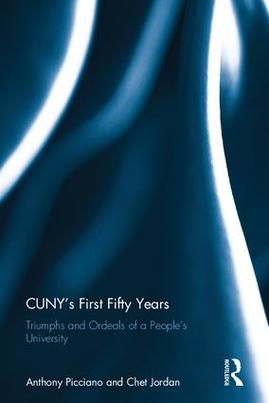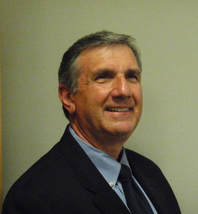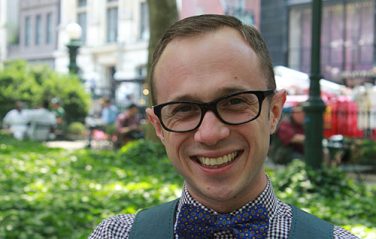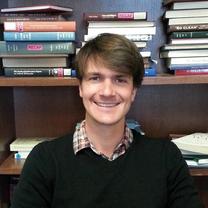Fifty Years of Struggle at NYC's Public University: An interview with Anthony G. Picciano & Chet Jordan
Today on Gotham, editor Nick Juravich sits down with Anthony Picciano, Professor of Urban Education at Hunter College and The Graduate Center, and Chet Jordan, Ph.D. student in Urban Education at the Graduate Center, to discuss their new book, CUNY's First Fifty Years, which traces the story of the nation’s largest urban university from its inception as CUNY in 1961 through the forces and events shaping it today.
We typically start with the "how did you come to write this book?" question, but as you've posted a very clear answer to this on the GC Commons, I'll just ask, any additional thoughts?
It’s important to note that this book represents a collaboration between two authors with ties to the City University of New York. Tony started as a student at Hunter College in 1965 and, except for two years at the State University of New York at New Paltz, has been at CUNY ever since. He has held administrative or faculty positions at several CUNY colleges including Hunter College, Lehman College, Medgar Evers College, the College of Staten Island, the School of Professional Studies, and the CUNY Graduate Center. At the time of the writing, he was Professor and Executive Officer of the Ph.D. Program in Urban Education at the CUNY Graduate Center as well as a Professor in the School of Education at Hunter College.
Chet was welcomed to CUNY to the Masters Program by the English faculty at Brooklyn College in 2010. As a graduate student, Chet was supported by Janet Moser, James Davis, and Mark Patkowski in teaching his first undergraduate course in Freshman Composition. From there, he taught courses at the College of Staten Island before he was invited to join the faculty of the New Community College at CUNY (Guttman) in August 2012. At the time of this writing, Chet was finishing his fifth year as a faculty member at Guttman Community College.
The idea for this book arose when Tony taught a seminar in 2012 commemorating the 50th Anniversary of the founding of CUNY. He has since taught several courses with colleagues, including Steve Brier and Matthew Goldstein, on higher education, drawing frequently on CUNY’s history for examples. The material from these courses helped form the foundation for the first half of this book. In addition to teaching at Guttman Community College, Chet was a doctoral student at the CUNY Graduate Center who has been conducting research on student experiences at CUNY community colleges. His research provided important insights for the second half of the book. Co-authoring this book represented a unique collaboration between two CUNY faculty members with very different perspectives and associations with the university, including the old and the new; the senior and community colleges; administration, faculty, and students. This was not meant to be an all-encompassing history of CUNY. Such a book would require thousands and thousands of pages. Instead, it was meant as a kind of character sketch of a great institution. We also hoped it might spur interest in CUNY as a research topic for others considering inquiry into higher education.
Lastly, the generation of faculty and administrators hired in the 1960s/70s already is retired or is close to retiring. Those of us who belong to that generation need to start recording our memories and preserving the institutional history. Maybe this book will help generate some interest among others to preserve what they have experienced at our university.
As historians, we like process questions. One set concerns archives and sources: what did you draw on in writing this book? Are there particularly rich archives or collections in the CUNY system that researchers of higher-ed topics should know about? Did you find anything in your archives (or Chet, in your oral histories) that surprised you, or that forced you to rethink or reshape the project?
One of the critical pieces of archival material that truly shapes CUNY’s history from a range of perspectives is the comprehensive database of student newspapers at City College. Someone undertook the momentous task of digitizing decades of newspapers that detail the day-to-day events of the college and CUNY at-large that no other resource does. Brooklyn College and Queens College also have incredible archives including administrative documents that would otherwise be inaccessible to the public. Additionally, and equally as important, the CUNY Board of Trustees, formerly the Board of Higher Education, has maintained detailed digital records of minutes of full board and committee meetings. Much of the chapter outlining the end of remediation in the late 1990s just as Matthew Goldstein becomes Chancellor is drawn from these minutes. At times, they are incredibly dramatic and detail a wide range of stories we would have otherwise forgotten.
Another set concerns writing. This is a slim volume (123 pages, by my count) and, as you describe it, a "character sketch" of CUNY, not an exhaustive biography (which might well look something like Gibbon's Decline and Fall if you dared attempt it). How did you select the periodizations and the examples you use? Was there anything that you cut in the edits that was tough to leave out, or that you would like to highlight here?
This is a great question. First, following the book’s introduction and a brief history leading up to the establishment of CUNY in 1961, we organized the book chronologically representing each decade from the 1960s to the present in a chapter. We reviewed whatever material we could find and chose several important developments that occurred in each decade for the treatment in the chapter. We also spoke to a number of colleagues who have had long associations with CUNY.
Second, there was a great deal we left out. There are so many individual stories of the people (faculty, students, administrators) that could fill volumes if told in their entirety. For instance, we devote several pages to Buell Gallagher, the president of City College in the 1960s, mostly in reference to his negotiations with students during the open admissions decisions in 1969. However, there is an entire biography waiting to be written about him. Before coming to CUNY, he had accomplished a great deal as a white college president at the historically black Talladega College, as an activist with the NAACP, as a major author on race relations, and as a senior administrator in the Office of Education under President Harry. S. Truman. His resignation from CCNY right in the middle of the student strikes was extremely difficult for him. Other than several mentions of him in a memoir written by Robert Marshak, we do not have a full accounting of his mindset during and after 1969.
There are also many sad stories of faculty colleagues, who lost their positions during the retrenchment in the mid-1970s. Each college could have had a chapter devoted to how this dark part of our history played out and affected young and old, faculty and administrators.
The period of the 1980s at CUNY has had very little written about it. The move to New York State funding was not a panacea by any means. For most of this decade, financial support was more about maintaining existence than moving forward with major new initiatives, the exceptions being the Sophie Davis School at City College and the Law School. An in-depth financial policy analysis of this decade would show very modest operating budgets in what was generally considered a stable fiscal period. And CUNY never returned to the funding of the early 1970s as many had hoped. It was, however, the decade when major capital projects provided hope for a brighter future.
The battles between Mayor Giuliani and CUNY in the 1990s are legendary. He and his appointees on the CUNY Board of Trustees were merciless in disparaging CUNY (“let’s blow it up”) as an institution adrift without direction. This period has been the subject of articles in the general press and media but there are precious few in-depth analyses of how this period affected the institution, the morale, and the people. The succession of chancellors from Anne Reynolds to Christoph Kimmich to Matt Goldstein is ripe for a study of leadership in public higher education.
Picking up on the idea of the book as a "character sketch," what are the essential changes and continuities in this story, as you see them? Put another way, what character traits does today's University retain from the CUNY of 1961, and what traits have emerged in the intervening fifty years?
One of the most noticeable shifts, I would say, in the last fifty years has been the slow move toward centralization, a major theme in the book. In 1961, CUNY organized as one university but for decades the colleges largely retained academic and administrative discretion for their campuses which we see played out in the tenure of several powerful presidents including Buell Gallagher (City College), Donna Shalala (Hunter College), and Gerald Lynch (John Jay College). The effort to centralize and the transition of decision-making power from the campuses to the Central Office came in the late 1990s and really picked up speed in the first decade of the 21st Century. Matthew Goldstein was, in so many ways, an enormously impactful chief executive, one that had both the vision and drive to standardize university policy. One key initiative that comes to mind is Pathways. In 2011, the Board of Trustees adopted the new general education framework called the Pathways Initiative. It represented the first total overhaul of the general education and degree requirements at CUNY, ensuring that students transferring from one college to another within the system would be compensated for credits taken elsewhere at their new college. Transfer was an historic problem. Centralizing the transfer process so that students didn’t lose credits and financial aid was only possible through the belief that CUNY was one university. Executive Vice Chancellor and University Provost Lexa Logue was the chief architect of the initiative and encountered enormous resistance from portions of the faculty. That debate, in our view, was partially about the unwillingness of the colleges to forego autonomy in favor of centralization. Even in the move toward the “one university” identity, CUNY has remained committed to offering inexpensive undergraduate education to the people of the City of New York. Access and opportunity remain at the forefront of our mission.
You lay out some key themes and ongoing tensions in the book's introduction: tensions between external and internal pressures, debates about merit and access, questions of centralization and governance, and moments of expansion and contraction. All of these persist into our own moment, of course, but are there particular ways in which CUNY has resolved, or sought to resolve, these tensions that have worked well (and if so, how)?
CUNY’s tensions are largely unresolvable, and in many ways, give the university the kind of energy it needs to sustain over 270,000 students. At its core, CUNY is a mechanism of New York State and City politics just as much as it is a site of education. As we mentioned in the book, it is often at the crosshairs of public debate about funding, admissions standards, remediation, graduation rates, and experimentation. In many ways, its Chancellors have been enormously powerful political figures on the national stage. The conflicts around faculty governance, administrative oversight, collective bargaining, and student academic outcomes are all part of a larger dialogue around equity and opportunity that reflect the tenor of the time. It has been a year since we wrote the Afterword foreshadowing a possible downshift in the American higher education system following the election of Donald Trump. While funding for postsecondary education certainly has not increased, we do see CUNY fulfilling its mission of providing access to a college education in precarious times. Taking the lead on issues like DACA and women’s rights, CUNY as at the leading edge of the national conversation on social issues once again. Our esteemed Graduate Center is advancing social science research in the field of higher education pedagogy so that our doctoral students become incredible teachers for our students. We are also proud of our community colleges that have introduced new programs to help students graduate on time and get a four-year degree. In a moment of political polarization, CUNY students are on the rise, are outspoken, and are committed to our mission. It is within that tension that we do our best because it gives us a space to talk and to problem solve. CUNY has never been a passive, restful institution. We are always in flux, always in motion, and our energy grows out of our conflicts.
You also note, in the intro, that CUNY has been a "pawn in New York politics" since its inception. What are the key contours of this story? How has this played out in the recent past, in a moment when our mayor and governor (both Democrats) cannot get along about anything?
The involvement of multiple key political figures has been a constant theme at CUNY. During our investigations, the theme of CUNY as a “pawn” reverberated over and over again. Here are several examples.
Early/mid 1960s: New York State Governor Nelson Rockefeller pushed strongly for CUNY to end its free tuition policy. Mayors Robert Wagner and John Lindsay as well as the Board of Higher Education resisted this but Rockefeller was persistent and overtly threatened the university over and over again if it did not impose tuition.
Late 1960s: Open admissions saw many politicians get involved (Mayor John Lindsay, New York City Comptroller Mario Procaccino, Congressmen Mario Biaggi and Adam Clayton Powell, Jr. and Manhattan Borough President Percy Sutton,) by taking sides, seeking injunctions against the students, and insisting on calling for the police to end the strikes. Along with hot button issues such as establishing a Civilian Review Board for the New York City Police Department, open admissions became one of the major points of contention among candidates in the mayoral election in 1969.
1970s-1980s: Fiscal crises saw Mayor Abe Beame, Governor Hugh Carey, and the NYS Legislature’s Black and Puerto Rican Caucus jockey for position on how to save the university. There were several months in 1976 when calls for the closing of colleges, even by some of CUNY’s own college presidents, divided and shook the confidence of many faculty and administrators. Massive marches and rallies at City Hall were staged to save the newer and smaller colleges in the university. Without the involvement of key New York State legislators it is quite possible that institutions such as Hostos Community College and Medgar Evers College would have been closed. As it turned out, the major structural change in the university was the merger of Staten Island Community College and Richmond College. It resulted in the largest retrenchment on a per capita basis of any units within the university.
1990s/early 2000s: Mayor Rudy Giuliani, Governor George Pataki and their appointed Trustees such as Herman Badillo and Anne Paolucci heaped a storm of criticism on CUNY and its administrators while calling for a return to the “glory years” prior to open admissions when the university was highly selective and largely white.
Mid-later 2000s: Governor Andrew Cuomo, Mayor Bill de Blasio, and Chancellor J.B. Millken have been involved in a yo-yoing funding situation that within the space of a couple of years has moved between agony and ecstasy. Andrew Cuomo in his proposed budget in 2015 called for a reduction of $485 million in the State’s contribution to CUNY which would have been catastrophic; such was the animosity between the Governor and Mayor de Blasio. In 2017, Governor Cuomo, possibly seeing a presidential run in 2020, announced the new Excelsior Program that would guarantee free tuition for most CUNY and SUNY undergraduates. At the time of this interview, CUNY was seeing record numbers of new applicants as a result of the Excelsior Program but was in the midst of budget negotiations with the State seeking support for this growing student population.
Following on that, is CUNY always a pawn? Are there moments when the University - whether through mobilizing its alumni, or through faculty or student action - has driven political change or changed political conversations in New York City and State?
Absolutely. CUNY is, with no doubt, one of the most important institutions in New York City. It is responsible for educating hundreds of thousands of students and energizes the New York economy like no other entity. However, the university is set up to handle its political position. One of the unique features of CUNY is its relationship to the Professional Staff Congress, the collective bargaining unit that serves the faculty and professional staff. The union is remarkably powerful and has provided predictable salaries and labor safeguards for decades for its constituents. Most recently, the union showed its true political power by organizing a forceful movement to pressure the city and state to settle a long overdue employment contract. It won, but mobilized to authorize a strike if necessary in order to do so. It is certainly a symbol of the power the faculty and staff have to influence change in such a large university.
CUNY was created in 1961, at the cusp of a series of massive upheavals in US history. From the freedom struggles of the 1960s to the "urban crisis" of the 1970s and 1980s, to the arrival of new immigrant communities, and to today's "urban renaissance" (and debates about who it benefits and who it leaves out), the political economy and political culture of New York has changed dramatically, and multiple times, in the past half-century. What have these changes meant for the nation's largest "urban university?" To rephrase and sort of follow up, has the idea of an "urban university" — what it is and what it does — changed with these changing contexts, and if so, how?
This is a complex question which can be answered simply: CUNY has constantly been attuned to national and local movements and has adjusted accordingly, of course, always depending upon the availability of resources. There are obvious examples such as the civil rights movement of the 1960s and the calls for greater community control that surely sparked the movement to open admissions as well as the expansion of the colleges into struggling neighborhoods in the Bronx, Brooklyn and Queens. As New York City lost a good portion of its manufacturing base in the 1970s and 1980s, CUNY’s academic programs began to shift to technology, professional programs, and career education. To this day, CUNY has one of the largest enrollments in non-credit adult and continuing education of any institution in the country. In the 2000s, CUNY focused on expanding a number of small but needed programs in STEM, journalism, and health sciences, etc. The administrative structures related to semester scheduling, academic advisement, and online education were altered to serve busy urban professionals who needed new access vehicles to complete education. However, the core focus of CUNY, from its beginnings at CCNY and Hunter College, to provide social and economic opportunities for New York City residents of modest means to achieve a higher education has not changed. However, the burden for much of this has shifted from state and local government funding to student tuition. Through the mid 1970s, students attended CUNY colleges without the burden of paying tuition. Since 2000, CUNY students have seen successive waves of tuition increases until Governor Andrew Cuomo established the tuition-free Excelsior program in 2017.
A follow-up to the above: how might we understand CUNY as an actor in these larger urban changes, and not just as an institution dealing with their impact? Are there things that CUNY has done not just to respond to these outside pressures, but rather to shape the city?
The past decade has really focused on improving graduation rates at CUNY. The presumption is that the more students a college graduates the more the labor force in New York will be able to draw from an educated pool of individuals. This is only partially true. The national education agenda under President Obama pushed colleges to become more accountable for their graduation rates, particularly in the community colleges where graduation rates are so low. This is certainly a noble objective and one that CUNY has responded to. However, the other side of that involves learning and long-term intellectual sustainability. The question should now be, are we educating a student body that can engage intellectually and pragmatically with the complexities of the workforce over the long-term after graduation from CUNY? That’s the bread and butter. In other words, are we educating students or are we graduating them? These are two entirely different objectives. CUNY has the responsibility to examine this phenomenon and its results will tell us whether or not we are contributing to the regional and local social and economic environment in a productive way. That is our next challenge. Programs like the Accelerated Study in Associate Programs (ASAP) and the Guttman Community College model have been heralded as success stories in raising graduation rates. Now we have to get into the weeds a bit to make sure we are educating students in a way that is meaningful. Our students are widely diverse and deserve a world-class education. In so doing, CUNY is directly responsible for shaping the future of the city.
You note, in the afterword, that CUNY's greatest contribution (drawing on the Equal Opportunity Project study) may be its role as an "American Dream Machine" (to borrow the phrasing of the subway ads)? What, in your opinion, does CUNY need to do going forward to continue making these contributions? Looking back at the book you've written, are there takeaways from it that you hope CUNY students, faculty, and administrators can use as they think about the future of the institution?
CUNY is an “American Dream Machine” for many students of modest means and especially those from under-represented minorities and immigrants. The Equal Opportunity Project study verifies this in a major way. There is no reason why CUNY should move away from this position in the future. We see a bright decade ahead as long as the political winds in Albany continue to blow in the direction of progressives who see higher education as an important societal equalizer and social benefit. Hopefully, this will not change as it has in other states such as Wisconsin and Illinois. Hundreds of thousands of students during the past fifty years were given the opportunity at our university to move forward socially and economically. Regardless of political and fiscal adversity, CUNY continues to welcome students into its classrooms. It has been an honor to teach and work with them in this, the “people’s university.”



